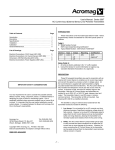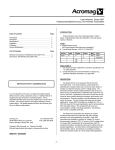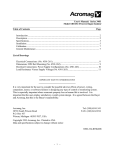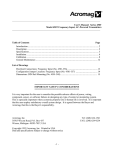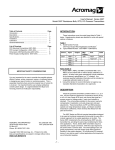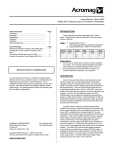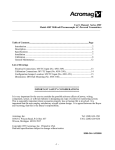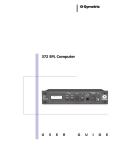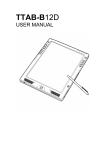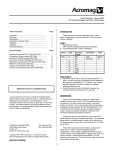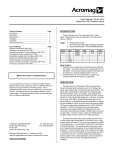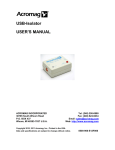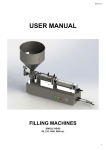Download - 1 - User`s Manual: Series 350T Model 350T Curr
Transcript
______________________________________________________________________________ User's Manual: Series 350T Model 350T Current/Voltage Input DC Powered Transmitters ______________________________________________________________________________ Table of Contents ........................................................................................................Page Introduction ...................................................................................................................2 Description ....................................................................................................................2 Specifications ................................................................................................................3 Installation.....................................................................................................................6 Calibration.....................................................................................................................8 General Maintenance ..................................................................................................11 List of Drawings Electrical Connections: C1/Vx Input (No. 4501-296) ................................................12 Configuration Jumper Location: C1/Vx Input (No. 4501-297) ..................................13 Dimensions: DIN Rail Mounting (No. 4501-252). .....................................................14 Electrical Connections: Power Supply Configurations (No. 4501-254).....................15 =================================== IMPORTANT SAFETY CONSIDERATIONS =================================== It is very important for the user to consider the possible adverse effects of power, wiring, component, sensor, or software failures in designing any type of control or monitoring system. This is especially important where economic property loss or human life is involved. It is important that the user employ satisfactory overall system design. It is agreed between the Buyer and Acromag, that this is the Buyer's responsibility. Acromag, Inc. 30765 Wixom Road, P.O. Box 437 Wixom, Michigan 48393-7037, USA Tel: (248) 624-1541 FAX: (248) 624-9234 Copyright 1993 Acromag, Inc. Printed in USA Data and specifications subject to change without notice 8500-330-B93H002 -1- Series 350T User's Manual DC Current/Voltage ______________________________________________________________________________ INSTRUCTIONS: SERIES 350T Current/Voltage Input DC Powered Transmitters INTRODUCTION: These instructions cover the model types listed in Table 1 below. Supplementary sheets are attached for units with special options or features. Table 1: A. Model Number Format: 350T-Input-Output-Mtg-Certification-Calibration B. Typical Model Number: 350T-C1-Y-DIN-NCR-C Series 350T -Input -C1 -Output -Y -V1 -V2 -V3 -V4 -V5 -V6 -V0 -V5 -Mounting -DIN -Certification -NCR -Approval** -Calib. * (Blank) -C Notes (Table 1): * Unit can be ordered with or without factory calibration; if unit is factory calibrated to a customer's specifications, the model number suffix "-C" will indicate this. Any customer specified calibration information will be included on a separate calibration label on the unit. ** Consult the factory for current information on agency (e.g. Canadian Standards Association, etc.) approvals. DESCRIPTION: These DC powered transmitters condition DC voltage (either unipolar or bipolar), from 100mV to 100V DC spans, and convert the input signal to a process current or voltage output. Input circuit isolation is standard. 2 Series 350T User's Manual DC Current/Voltage ______________________________________________________________________________ The 350T Series are DIN-rail mounted transmitters designed to be used as functional components that provide the user with a modular approach to the varied applications in the field. The Series 350T complements the Acromag Series 250T two-wire transmitter line, providing the same input conditioning for three-wire applications. That is, Series 350T transmitters require a separate power supply connection, while the output signal and DC power share a common lead. The small package size, low power requirements, and wide supply range offers maximum flexibility to the system designer. As a three-wired DC powered device, it can also be used in critical applications that require the use of redundant supplies. The Series 350T includes reverse polarity protection, current limiting, and operates from a single 10V to 36V DC supply. In applications requiring only a single transmitter, the 350T can use available DC power, or it can be wired to an optional Series 35PS power supply module. The Series 35PS power supply module receives it's power from either 115V AC or 230V AC. Applications requiring multiple transmitters at a single location can more efficiently share a single DC supply. The modular approach of this design and companion Acromag flat-pack modules allows additional transmitters, input modules, isolators, and alarms to be easily integrated, as required. See Drawing 4501-249 for a simplified Series 350T schematic. Input wiring is inserted in the bottom of the unit, while output and power wiring is inserted at the top of the unit. Screws to secure the wiring are located on the front panel. Connectors are screw-clamp type and accept wire size up to 14 AWG. SPECIFICATIONS: Function: This family of isolated, DC Voltage powered, transmitters condition either a DC current or voltage signal, provide input circuit isolation, and convert the input signal to a process current or voltage output. The output and DC power share a common terminal (3-Wire connection). Wide-range zero and span adjustments utilize 22-turn potentiometers which are accessible from the front of the unit. The transmitter is DIN-rail mounted. MODEL/SERIES: 350T- (Color coded with a white label) Input: DC Current and Voltage. Input span and zero ranges are adjustable as specified below, except for special ranges which are factory calibrated per customer specifications. Both the Span and Zero adjustment capability are covered in two ranges, and are configured by internal jumpers on the circuit board. 3 Series 350T User's Manual DC Current/Voltage ______________________________________________________________________________ -C1: DC Current: Span: 4.0 to 20.0mA DC. Zero: 0.0 to 16.0mA DC. Maximum full scale of 20.0mA DC. Input load is 10 ohms. -V1: DC Voltage: Span: 0.1 to 1.0V DC. Zero suppression from 0 to 25 percent of input span. Input impedance is 40M ohms at 0.4V span, typical; input current +/-10nA, typical. -V2: DC Voltage: Span: 1.0 to 10.0V DC. Zero suppression from 0 to 25 percent of input span. Input impedance is 100K ohms, typical. -V3: DC Voltage: Span 10.0 to 100.0V DC. Zero suppression from 0 to 25 percent of input span. Input impedance is 500K ohms, typical. -V4: DC Voltage, bipolar input: Span -/+0.1 to -/+1.0V DC. Signal is assumed to be symmetrical around 0 volts. Input impedance is 80M ohms at 0.8V span, typical; input current +/-10nA, typical. -V5: DC Voltage, bipolar input: Span -/+1.0 to -/+10.0V DC. Signal is assumed to be symmetrical around 0 volts. Input impedance is 100K ohms, typical. -V6: DC Voltage, bipolar input: Span -/+10.0 to -/+100.0V DC. Signal is assumed to be symmetrical around 0 volts. Input impedance is 500K ohms, typical. Input Impedance: Per input type, see Input description above. Isolation: The input circuit is electrically isolated from the output and power circuits, allowing the input to operate at up to 250V AC, or 354V DC off ground, on a continuous basis (will withstand 1500V AC dielectric strength test for one minute without breakdown). This complies with test requirements outlined in ANSI/ISA-S82.01-1988 for the voltage rating specified. OUTPUT: Process Current or Voltage output. The output shares a common with the power supply. Voltage outputs are designed to provide true voltage output, with zero volts included, and to be stable with capacitive loads. -Y : 4 to 20mA DC (see Load Resistance Range Equation below) -V0: 0 to 10V DC into 10,000 ohms or greater -V5: 0 to 5V DC into 5,000 ohms or greater 4 Series 350T User's Manual DC Current/Voltage ______________________________________________________________________________ Load Resistance Range Equation (-Y output option): The maximum load resistance for 20mA compliance is a function of input supply voltage as follows: R-Load (Maximum) = (Minimum VDC supply - 2.5V) / 0.02A At 10.0V DC supply, R-Load = 0 to 375 ohms At 12.5V DC supply, R-Load = 0 to 500 ohms At 15.0V DC supply, R-Load = 0 to 625 ohms At 24.0V DC supply, R-Load = 0 to 1075 ohms Output Limiting: Voltage units: 150% of full scale output, nominal; Current units; 125% of full-scale output, nominal. Output Ripple: Less than +/-0.1% of the maximum output span. Power: An external DC power supply is required between the output (P) and (-) terminals. Transmitter current is for rated supply inputs, full-scale output, and no-load on voltage output units. Diode on transmitter provides reverse polarity protection. CAUTION: Do not exceed 36V DC peak, to avoid damage to the transmitter. A. Process Current Output (-Y): +10.0V to 36.0V DC, 30mA (35mA at current limit). B. Voltage Output (-V0): +12.5V to 36.0V DC, 9mA maximum. C. Voltage Output (-V5): +10.0V to 36.0V DC, 9mA maximum. Power Supply Effect: DC Volts: less than +/-0.001% of output span per volt DC, for rated power supply variations. 60/120 Hz ripple: less than +/-0.01% of span per volt peak-to-peak of power supply ripple. Reference Test Conditions: Input: 1-10V DC with a 100 ohm resistive source; Output (-Y units): 4-20mA DC (500 ohm load); Output (-Vx units): 0-10V DC into 10K ohms or greater; Ambient 77oF (25oC); +15V DC supply. Accuracy: Better than +/-0.1% of calibrated span or +/-0.25 mV, whichever is greater. The error includes the combined effects of transmitter repeatability, hysteresis, terminal point linearity, and adjustment resolution. Does not include sensor error. Ambient Temperature Range: -13oF to 185oF (-25oC to 85oC). Ambient Temperature Effect: Less than +/-0.01% of output span per oF (+/-0.018% per oC) over the ambient temperature range for reference test conditions. Specification includes the combined effects of zero and span over temperature. Bandwidth: -3dB at 3 Hz, typical. Response Time: For a step input, the output reaches 98% of output span in 300ms, typical. 5 Series 350T User's Manual DC Current/Voltage ______________________________________________________________________________ Noise Rejection: Common Mode: 120dB at 60 Hz, 100 ohm unbalance, typical. Normal Mode: 30dB at 60 Hz, 100 ohm source, typical. RFI Resistance: Less than +/-0.5% of output span with RFI field strengths of up to 10V/meter at frequencies of 27, 151 and 467 MHz. EMI Resistance: Less than +/-0.25% of output span effect with switching solenoids or commutator motors. Surge Withstand Capability (SWC): Input/Output terminations rated per ANSI/IEEE C37.90-1978. Unit is tested to a standardized test waveform that is representative of surges (high frequency transient electrical interference), observed in actual installations. Construction: Printed Circuit Boards: Military grade FR-4 epoxy glass circuit board. Terminals: Compression type, wire size 14 AWG maximum. Case: Self-extinguishing NYLON Type 6.6 polyamide thermoplastic UL94 V-2, color black. General Purpose, NEMA Type 1 enclosure. Printed Circuit Board Coating: Fungus resistant acrylic conformal coat. Mounting Position: Position insensitive. MOUNTING: -DIN: General Purpose Housing, DIN-Rail Mount - "G" & "T" rails. "G" Rail (32mm), Type EN50035; "T" Rail (35mm), Type EN50022. Refer to Drawing 4501-252 for outline and clearance dimensions. Shipping Weight: 1 pound (0.45 Kg) packed. CERTIFICATION: Consult the factory for current information on the availability of agency (e.g. Canadian Standards Association, Factory Mutual, etc.) approvals. -NCR: No Certification Required. INSTALLATION: The transmitter is packaged in a general purpose type of enclosure. Use an auxiliary enclosure to protect against unfavorable environments and locations. Maximum operating ambient temperatures should be within -13 to 185oF (-25 to 85oC) for satisfactory performance. If the unit is factory calibrated, it is ready for installation. Connect as shown in the connection diagram of Drawing 4501-296. If the unit is not factory calibrated, refer to the "CALIBRATION" section. 6 Series 350T User's Manual DC Current/Voltage ______________________________________________________________________________ Mounting: Mount transmitter assembly - refer to Drawing 4501-252 for mounting and clearance dimensions. DIN Rail Mounting: Using suitable fastening hardware, secure the DIN rail to the designated mounting surface. A transmitter, can be mounted to either the "T" or "G" Rail. Installation of the transmitter to the rail depends on the type of DIN rail used. Units can be mounted side by side on 1.0 inch centers, if required. "T" Rail (35mm), Type EN50022: To attach a transmitter to this style of DIN rail, angle the top of the unit towards the rail and locate the top groove of the adapter over the upper lip of the rail. Firmly push the unit towards the rail until it snaps solidly into place. To remove a transmitter, insert a screwdriver into the lower arm of the connector and pull downwards while applying outward pressure to the bottom of the unit. "G" Rail (32mm), Type EN50035: To attach a transmitter to this style of DIN rail, angle the unit so that the upper groove of the adapter hooks under the top lip of the rail. Firmly push the unit towards the rail until it snaps solidly into place. To remove a transmitter, pull the lower part of the unit outwards until it releases from the rail, lift unit from rail. Electrical Connections: Regardless of the mounting configuration employed, the electrical connections are basically identical. The wire size used to connect the unit to the control system is not critical. All terminal strips can accommodate wire from 14-26 AWG. Strip back the insulation 1/4-inch on each lead before installing it into the terminal block. Input wiring may be either shielded or unshielded twisted pair. Output wires should be twisted pair. Since common mode voltages can exist on signal wiring, adequate wire insulation should be used and proper wiring practices followed. It is recommended that the output and power wiring be separated from the signal wiring for safety as well as for low noise pickup. 7 Series 350T User's Manual DC Current/Voltage ______________________________________________________________________________ 1. Power: Connect DC power supply per connection diagram, refer to Drawing 4501-249. These transmitters operate from DC power supplies only. Power supply voltage is not critical and normally should be from 10.0V to 36V DC. The supply voltage must not exceed 36 Volts, even instantaneously, and must be adequate to furnish full-scale current or voltage to the load. Variations in power supply voltage, above the minimum required, or load resistance have negligible effect on transmitter accuracy. Refer to "POWER" in the preceding SPECFICATIONS section for current requirements. The minus (-) power supply lead and the minus (-) output lead share a common terminal. This device includes input current limiting and reverse polarity protection. Refer to Drawing 4501-254 for other power supply configurations. Ripple and Noise: Power supply ripple at 60Hz/120Hz is reduced at the load by the transmitter. The ripple at the load will be less than +/-0.01% of span per volt peak-to-peak of power supply ripple. 2. Output: Connect output per connection diagram, refer to Drawing 4501-296. Load range is a function of the module's output type; refer to "Output" in the preceding "SPECIFICATIONS" section. The output shares a common with the power supply. 3. Grounding: The transmitter housing is plastic and does not require an earth ground connection. 4. Input: Connect input per connection diagram, observe proper polarity, see label for input type. If unit is factory calibrated, the calibration label indicates range of input. NOTE: The input circuit is electrically isolated from the output/power circuit allowing the input to operate up to 250V AC or 354V DC off ground on a continuous basis. CALIBRATION: A. TRANSMITTER: This section provides information for configuration and calibration. If the unit was factory calibrated, jumpers have been placed in their proper positions and verification of the calibration can be made per the Adjustment Procedure. If the calibration of the unit is to be changed, first go to the "Shunt Block Configuration Procedure" before going to the Transmitter Adjustment Procedure." 8 Series 350T User's Manual DC Current/Voltage ______________________________________________________________________________ 1. Transmitter - Shunt Block Configuration Procedure: The Zero and Span adjustment range are configured by jumpers (refer to Drawing 4501-297 for details). To gain access to the configuration jumpers, first remove transmitter from the installation. Second, remove the circuit boards from the plastic enclosure as described in the Disassembly Procedure below. Third, configure jumpers (shunt blocks) as described in the Jumper Configuration procedure below. NOTE: Calibration per the Adjustment Procedure should be performed before the circuit boards are reassembled within the plastic enclosure. Disassembly Procedure for the 350T Plastic Housing: The plastic housing has no screws, it "snaps" together. A flat-head screwdriver (Acromag 5021-216 or equivalent) is needed to pry the housing apart as described in the following steps. CAUTION: Do not push the screwdriver blade into the housing more than approximately 0.1 inches while prying it apart. Handling of the printed circuit boards should only be done at a static-free workstation, otherwise, damage to the electronics could result. 1. To begin disassembly (refer to Drawing 4501-297) place the screwdriver at point A (left side of the transmitter). While pressing the blade into the seam, use a twisting motion to separate the sides slightly. Repeat this operation at point B. 2. Now that the two pieces have been partially separated, use the screwdriver blade to work the left side of the package loose by working around the transmitter and carefully prying the sides further apart. Repeat this action until it is easy to remove the left side from the plastic pins holding the pieces together. 3. Repeat this operation for the right side starting at points C and D. CAUTION: If the two pc boards become separated while taking the package apart, re-align the boards making sure that the two headers (pins) and sockets at locations E and F are properly aligned and carefully push the boards back together. Jumper Configuration (Shunt Blocks): Shunt blocks are provided to accommodate in-field configuration changes. In case of misplacement, additional shunt blocks may be ordered from the factory. When ordering additional shunt blocks, refer to Acromag Part Number 1004-332. 9 Series 350T User's Manual DC Current/Voltage ______________________________________________________________________________ 1. 1. Zero / Span Range: The Zero and Span shunt blocks should initially be placed in their default position, typically "IN" for each case, see Drawing 4501-297. During the process of Calibration, the need to change these jumper positions will be determined. 2. Important: Mark the Transmitter's Configuration on the calibration label located on the enclosure. Example: IN: 0 to 1.0V DC. Jumper Configuration Example: Configure internal jumpers as follows: A. Zero and Span Range: Zero & Span Jumpers both "IN". 2. Transmitter - Adjustment Procedure: Connect transmitter as shown in the connection diagram Drawing 4501-296. For best results, the input signal source should be adjustable over the entire input range of the unit, settable to an accuracy of 0.1% or better, and have a source resistance of 100 ohms or less. The power supply voltage must be between 8 and 36 Volts DC at the terminals of the transmitter. The output voltage must be measured to 0.1% accuracy or better for proper results. The Zero and Span adjustments are accessible on the front panel of the transmitter, see Drawing 4501-296 for their location. The screwdriver blade, used to adjust the potentiometers, should not be more than 0.1 inch (2.54mm) wide. For optimum performance, the span and zero capability of the unit are covered in two ranges, which are programmed by internal jumpers on the circuit board. The Span (S) and Zero (Z) jumpers change the range of adjustment of the span and zero potentiometers. If during calibration, the zero potentiometer range is found to be inadequate, move the Zero Shunt from "IN" (Default Position) to "OUT". If during calibration, the span potentiometer range is found to be inadequate, move the Span Shunt from "IN" (Default Position) to "OUT". Only move the Shunt Jumpers when it is required. For Shunt Block location, refer to Drawing 4501-297. Transmitter - Calibration Example 1 (C1, V1, V2, and V3 models are similar) : MODEL : 350T-V1-Y-DIN-NCR Input : 0 to 1.0V DC. Output: 4-20mA DC 1. Set the input source to 0.000V DC. Adjust the Zero (Z) pot until the output reads 4.000mA DC. 2. Set the input source to 1.000V DC. Adjust the Span (S) pot until the output reads 20.000mA DC. 3. Repeat steps 1 and 2 above, until the readings converge. The instrument is now calibrated. Several mid-point values should also be checked to verify proper operation of the transmitter. 10 Series 350T User's Manual DC Current/Voltage ______________________________________________________________________________ 4. After the above calibration procedure is complete, install the transmitter PC Board assembly back into its case as described in the assembly procedure below. Transmitter - Calibration Example 2 (V4, V5, and V6 models are similar): MODEL : 350T-V4-Y-DIN-NCR Input : -0.4 to 0.4V DC. Output: 4-20mA DC 1. Set the input source to 0.0000V DC. Adjust the Zero (Z) pot until the output reads 12.000mA DC. 2. Set the input source to -0.4000V DC. Adjust the Span (S) pot until the output reads 4.000mA DC. 3. Set the input source to 0.4000V DC. Take note of how far the output is from 20.000mA DC. Adjust the Span (S) pot to reduce the difference from 20.000mA DC by half. Adjust the Zero (Z) pot until the output reads 20.000mA DC. 4. Repeat steps 2 and 3 above, until the readings converge. The instrument is now calibrated. Several mid-point values should also be checked to verify proper operation of the transmitter. 5. After the above calibration procedure is complete, install the transmitter PC Board assembly back into its case as described in the assembly procedure below. Assembly Procedure for the 350T Plastic Housing: NOTE: The Model/Serial Number label is attached to the left plastic side. 1. Refer to Drawing 4501-297 and line up the left plastic side with the board and terminal assembly. Carefully but firmly press the pieces together. 2. Before installing the right side, place the mounting bracket (unique to the mounting type you have) around the pins at the back of the housing. 3. Line up the right side of the housing with the assembly and carefully but firmly press the pieces together. GENERAL MAINTENANCE: The transmitter contains solid-state components and requires no maintenance except for periodic cleaning and calibration verification. When a failure is suspected, a convenient method for identifying a faulty transmitter is to exchange it with a known good unit. It is highly recommended that a non-functioning transmitter be returned to Acromag for repair, since Acromag makes use of tested and burned-in parts, and in some cases, parts that have been selected for characteristics beyond that specified by the manufacturer. Further, Acromag has automated test equipment that thoroughly checks the performance of each transmitter. 11















